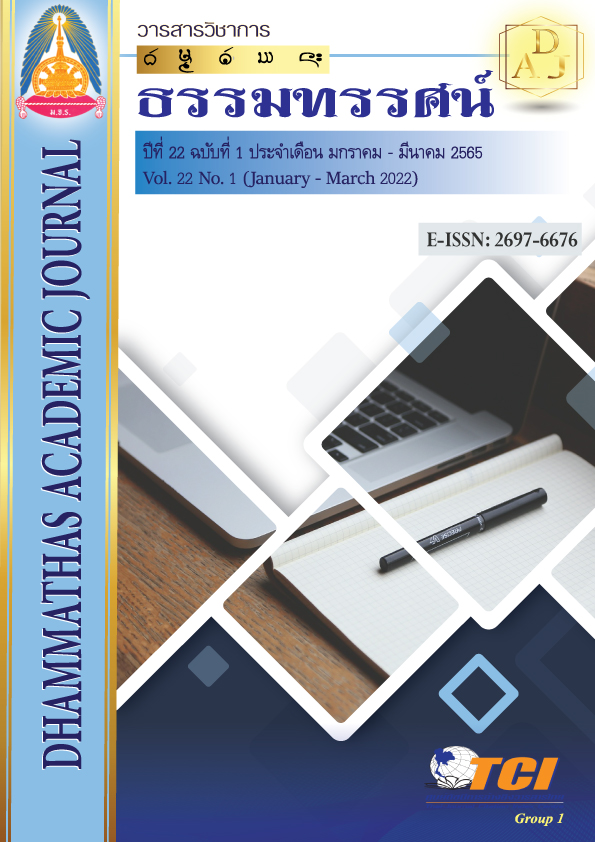Model of Clergy AdministrationIn dimension Region 9
Main Article Content
Abstract
The purpose of this research were; 1) to study the level of administration in Clergy dimension, region 9, 2) to study the factors affecting the administration in Clergy dimension, region 9, and 3) to establish and confirm the administrative model in Clergy dimension of the region 9. Using a mixed method research the research was divided into 2 phases as follows: Phase 1 was a quantitative research which aimed to study the factors affecting the administration of affairs in the dimensions of Clergy administration, region 9. The sample group consisted of 396 monks in Clergy, region 9. The second phase of research was qualitative research. to create and confirm the model, Related persons: 21 persons with knowledge and experience, 5 persons Use specific randomness The research tool used a semi-structured interview form. Quantitative questionnaire group meeting recording form and a questionnaire confirming the suitability of the administration model in Clergy dimension, region 9.
The results showed that:
1. The overall level of administration in the dimensions of Clergy administration, region 9 was at a high level ( = 3.83) when classified by aspects. It was found that the structure of Clergy was at the highest level (
= 3.89).
2. Factors affecting administration in the dimensions of Clergy administration, region 9, namely organization factor (f1), performance factor (f2) and factor of performance results (f3) were statistically significant at the 0.05 level.
3. The administration model in Clergy dimension, region 9 consists of planning, structuring, Personnel positioning, authority, assignment of work accordingly, Cooperate with external agencies performance, report and monitor the performance. To confirm the suitability of the model, it was found that all of the quartiles were less than 1.5, indicating that the model is suitable for building it is a model for administration in the dimensions of Clergy administration, Region 9.
Article Details

This work is licensed under a Creative Commons Attribution-NonCommercial-NoDerivatives 4.0 International License.
เพื่อให้เป็นไปตามกฎหมายลิขสิทธิ์ ผู้นิพนธ์ทุกท่านต้องลงลายมือชื่อในแบบฟอร์มใบมอบลิขสิทธิ์บทความ ให้แก่วารสารฯ พร้อมกับบทความต้นฉบับที่ได้แก้ไขครั้งสุดท้าย นอกจากนี้ ผู้นิพนธ์ทุกท่านต้องยืนยันว่าบทความ ต้นฉบับที่ส่งมาตีพิมพ์นั้น ได้ส่งมาตีพิมพ์เฉพาะในวารสาร วิชาการธรรม ทรรศน์ เพียงแห่งเดียวเท่านั้น หากมีการใช้ ภาพหรือตารางของผู้นิพนธ์อื่นที่ปรากฏในสิ่งตีพิมพ์อื่นมาแล้ว ผู้นิพนธ์ต้องขออนุญาตเจ้าของลิขสิทธิ์ก่อน พร้อมทั้ง แสดงหนังสือที่ได้รับการยินยอมต่อบรรณาธิการ ก่อนที่บทความจะได้รับการตีพิมพ์References
กฤศดา มมตะขบ. (2545). ทัศนคติของพระสงฆ์ในจังหวัดเชียงใหม่ต่อโครงสร้างอำนาจการปกครองวัดตามพระราชบัญญัติคณะสงฆ์ พ.ศ. 2505. (วิทยานิพนธ์รัฐศาสตรมหาบัณฑิต). เชียงใหม่: มหาวิทยาลัยเชียงใหม่.
ปัณณธร เธียรชัยพฤกษ์. (2563). การบริหารงานของวัดตามหลักธรรมาภิบาล. วารสารนวัตกรรมการศึกษาและการวิจัย, 4(1), 63-74.
พระครูจริยธรรมานุรักษ์ (วัลลภ จริยธมฺโม). (2563). สภาพปัญหาและแนวทางแก้ไขในการบริหารจัดการที่พักสงฆ์. วารสารศิลปการจัดการ, 4(3), 722-782.
พระเทพปริยัติสุธี (วรวิทย์ คงฺคปญฺโญ). (2545). การคณะสงฆ์และพระศาสนา. กรุงเทพฯ: มหาจุฬาลงกรณราชวิทยาลัย.
พระธรรมโกศาจารย์ (ประยูร ธมฺมจิตฺโต). (2549). พุทธวิธีในการบริหาร. (พิมพ์ครั้งที่ 4). กรุงเทพฯ: มหาจุฬาลงกรณราชวิทยาลัย.
พระปลัดสมพงศ์ กวิวํโส (หรรษาธาร). (2557). รูปแบบการบริหารจัดการวัดเพื่อเป็นศูนย์กลางการเรียนรู้ของชุมชนจังหวัดพระนครศรีอยุธยา. (ดุษฎีนิพนธ์ปรัชญาดุษฎีบัณฑิต). พระนครศรีอยุธยา: มหาวิทยาลัยมหาจุฬาลงกรณราชวิทยาลัย.
พระพรหมคุณาภรณ์ (ป.อ. ปยุตฺโต). (2556). พจนานุกรมพุทธศาสน์ ฉบับประมวลธรรม. (พิมพ์ครั้งที่ 24). กรุงเทพฯ: พระพุทธศาสนาของธรรมสภา.
พระมหาวิรุธ นิลเพ็ชร และคณะ. (2560). บทบาทของพระสังฆาธิการในการบริหารกิจการ คณะสงฆ์อำเภอวารินชำราบ จังหวัดอุบลราชธานี. วารสารแสงอิสาน, 14(2), 57-68.
พีระศิลป์ บุญทอง. (2561). การบริหารกิจการคณะสงฆ์ของคณะสงฆ์ในภาคใต้. วารสารมหาจุฬานาครทรรศน์, 5(1), 30-44.
ไพโรจน์ ดวงศรี. (2558). รูปแบบโครงสร้างองค์การ และบทบาทการบริหารงานของพระสังฆาธิการที่มีผลต่อการบริหารกิจการคณะสงฆ์. (วิทยานิพนธ์รัฐประศาสนศาสตรมหาบัณฑิต). กรุงเทพฯ: มหาวิทยาลัยศิลปากร.
สัญญา เคณาภูมิ และเสาวลักษณ์ โกศลกิตติอัมพร. (2558). ระเบียบวิธีวิจัยทางสังคมศาสตร์. มหาสารคาม: มหาวิทยาลัยราชภัฏมหาสารคาม.
สำนักงานพระพุทธศาสนาแห่งชาติ. (2564). ข้อมูลวัดและพระภิกษุสามเณร พ.ศ. 2564. เข้าถึงได้จาก https://www.onab.go.th/th/page/item/index/id/1
Yamane, T. (1973). Statistics: An Introductory Analysis. (2 rded). New York: Harper and Row.

